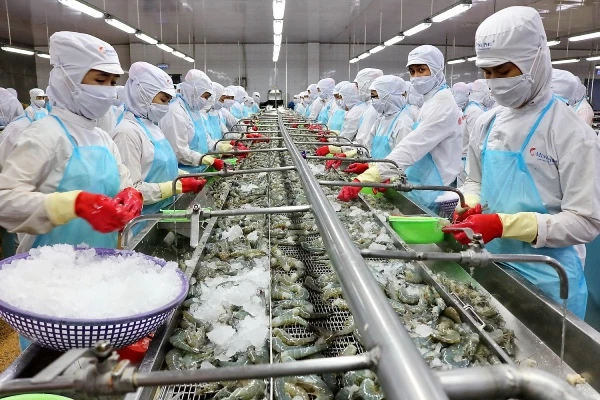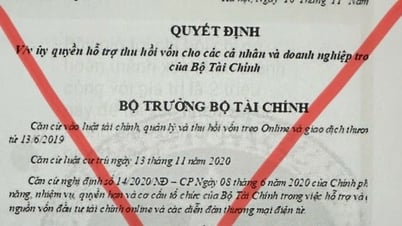DNVN - It is forecasted that in 2025, Vietnam's seafood exports may exceed the 11 billion USD mark - the highest level achieved in 2022. However, 2025 is also the year when the seafood industry will face many opportunities and challenges.
According to the Vietnam Association of Seafood Exporters and Producers (VASEP), in 2024, the Vietnamese seafood industry continued to make efforts to overcome difficulties and achieved an export turnover of over 10 billion USD, not to mention more than 250 million USD from exporting fishmeal - an important raw material for the animal feed industry.
In particular, the shrimp industry continues to be a bright spot with an export turnover of nearly 3.9 billion USD, an increase of 15% compared to 2023. Although the world shrimp consumption market is affected by inflation and fierce competition from major producing countries such as India, Ecuador, and Indonesia, the Vietnamese shrimp industry still maintains its growth momentum thanks to a strategy focusing on value-added products and segment diversification. Key products such as whiteleg shrimp, black tiger shrimp, lobster, and sea shrimp have affirmed their position in the international market.
The pangasius industry, after a difficult period due to rising transport costs and slow recovery of import prices, has returned to the $2 billion mark, up 9% year-on-year. Traditional markets such as the US, Brazil, Colombia and the CPTPP bloc have played a key role in the industry's recovery.

Vietnam's seafood exports could exceed the $11 billion mark by 2025.
Exports of exploited seafood, including tuna, crab, squid, octopus and mollusks, also recorded a turnover of more than 4 billion USD, despite difficulties in raw material sources and requirements to comply with IUU regulations.
Assessing export opportunities and prospects in 2025, Ms. Le Hang - Communications Director of VASEP said that in 2025, Vietnam's seafood exports could exceed the 11 billion USD mark - the highest level achieved in 2022. This result can be achieved thanks to favorable factors such as global economic recovery, increased consumption demand in major markets such as the US, EU, Japan and China, and potential expansion in regions such as Africa, Southeast Asia and the Middle East, which will create opportunities for Vietnamese seafood.
New generation free trade agreements such as EVFTA and CPTPP help reduce tariffs, increase competitiveness, and expand markets. The trend of shifting to value-added products and developing a circular economy is also an important strategy to increase the value of the seafood industry.
In particular, the new US tax policy, if it increases taxes on seafood from rival countries such as China, will be an opportunity for Vietnam to expand its market share thanks to product quality and competitive prices.
However, according to Ms. Hang, the seafood industry still faces many major challenges. Climate change has seriously affected aquatic resources, increasing the risk of disease and reducing the quality of raw materials. Production costs, from animal feed, fuel to transportation, have all increased, reducing the competitiveness of Vietnamese products.
Competition from major producing countries such as India, Thailand and Ecuador is increasingly fierce. IUU yellow cards, trade protection measures such as anti-dumping duties and strict quality regulations continue to be major barriers.
In addition, geopolitical fluctuations and global trade wars, especially between the US and China, can affect supply chains, input material prices and transportation costs.
To maintain growth and overcome challenges, the seafood industry needs to continue its sustainable development strategy, improve product quality and take full advantage of free trade agreements. At the same time, it needs to strengthen its capacity to adapt to climate change and geopolitical risks to maintain its position in the international market.
Minh Thu
Source: https://doanhnghiepvn.vn/kinh-te/co-hoi-va-thach-thuc-cua-nganh-thuy-san-nam-2025/20250101055621985




![[Photo] General Secretary To Lam receives Chief of the Central Office of the Lao People's Revolutionary Party](https://vphoto.vietnam.vn/thumb/1200x675/vietnam/resource/IMAGE/2025/5/30/140435f4b39d4599a3d17975dfb444c5)
![[Photo] National Conference "100 years of Vietnamese Revolutionary Press accompanying the glorious cause of the Party and the nation"](https://vphoto.vietnam.vn/thumb/1200x675/vietnam/resource/IMAGE/2025/5/30/1cf6cd5c8a934ebfa347028dcb08358c)
![[Photo] Journalists moved to tears at the Memorial Service for the soldiers who died in Gac Ma](https://vphoto.vietnam.vn/thumb/1200x675/vietnam/resource/IMAGE/2025/5/30/9454613a55c54c16bf8c0efa51883456)
![[Photo] A delegation of 100 journalists from the Vietnam Journalists Association visits the soldiers and people of Truong Sa island district.](https://vphoto.vietnam.vn/thumb/1200x675/vietnam/resource/IMAGE/2025/5/30/0984a986227d4e988177f560d2e1563e)


















































































Comment (0)